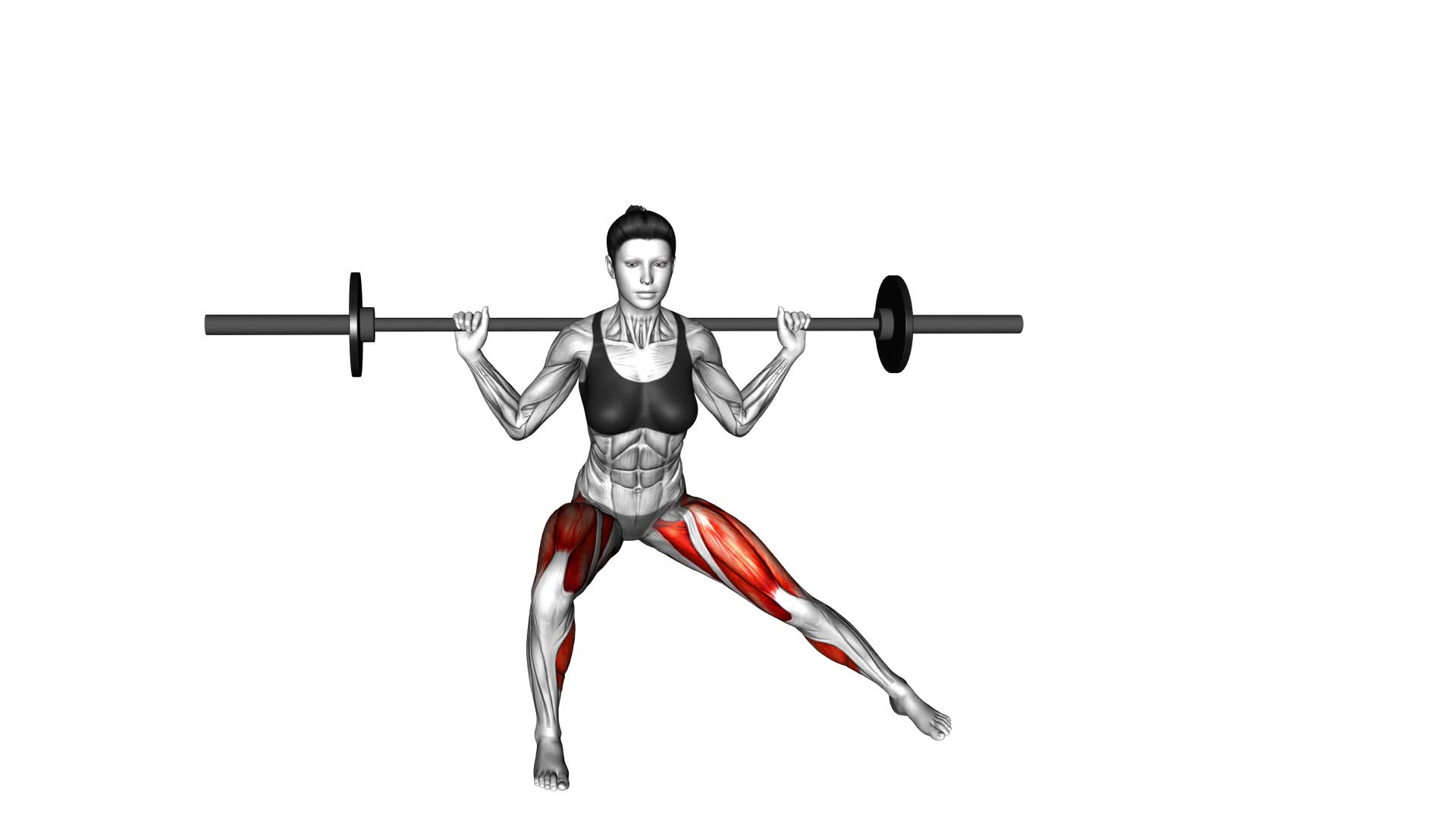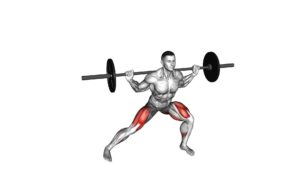Barbell Lateral Lunge (female) – Video Exercise Guide & Tips

Are you looking for a challenging lower body exercise to add to your routine?
Watch This Exercise Video
The barbell lateral lunge is perfect for you! This exercise targets your glutes, quads, and hamstrings while also improving hip mobility.
In this video exercise guide, we'll show you the proper form and technique, variations and modifications, as well as common mistakes to avoid.
Get ready to maximize your workout and achieve great results with the barbell lateral lunge!
Key Takeaways
- The barbell lateral lunge targets glutes, quads, and hamstrings.
- It improves hip mobility and activates specific muscles in the lower body.
- Adding resistance with a barbell increases muscle activation.
- Proper form and technique, such as maintaining balance and control, are essential for effective execution.
Benefits of the Barbell Lateral Lunge
The barbell lateral lunge offers multiple benefits for women looking to strengthen their lower body muscles and improve their overall fitness. This exercise is a great way to activate and target specific muscles in the lower body, including the quadriceps, hamstrings, glutes, and adductors. By incorporating the barbell into the lateral lunge, you add an extra challenge and resistance to the movement, leading to increased muscle activation.
One of the key benefits of the barbell lateral lunge is the increased stability it provides. As you perform the exercise, you're required to maintain balance and control throughout the movement. This not only strengthens the muscles of the lower body but also improves overall stability and coordination.
Proper form and technique are crucial when performing the barbell lateral lunge to ensure maximum benefits and minimize the risk of injury. By keeping your chest up, core engaged, and maintaining a slight bend in the knee of the lunging leg, you can effectively target the muscles while maintaining proper alignment. Additionally, it's important to use a weight that challenges you, but still allows you to maintain proper form throughout the exercise.
Proper Form and Technique
To ensure maximum effectiveness and reduce the risk of injury, focus on maintaining proper form and technique while performing the barbell lateral lunge. Proper form is crucial for targeting the correct muscles and preventing strain on your joints.
When executing the barbell lateral lunge, one common error isn't stepping out wide enough. Make sure to take a wide step to the side, keeping your toes pointed forward. This will engage your glutes, hamstrings, and quadriceps effectively. Another mistake is allowing your knee to cave inwards. To avoid this, keep your knee aligned with your toes throughout the movement.
Muscle activation is another important aspect of proper form. The barbell lateral lunge primarily targets the glutes, hamstrings, and quadriceps. To maximize activation in these muscles, focus on pushing through your heel as you return to the starting position. This will engage your posterior chain and help you maintain stability.
Remember to maintain an upright posture throughout the exercise, keeping your chest lifted and your core engaged. This will help you stabilize your body and prevent any unnecessary stress on your lower back.
Variations and Modifications
To modify the barbell lateral lunge, try incorporating different types of resistance, such as dumbbells or resistance bands. This will add variation to your workout and target your muscles in different ways.
Instead of using a barbell, hold a pair of dumbbells in your hands at your sides. This will challenge your balance and stability even more.
You can also try using a resistance band by placing it around your thighs or ankles. This will provide continuous tension throughout the movement, making it more challenging for your muscles.
Another modification you can try is to perform the lunge on an elevated surface, such as a step or box. This will increase the range of motion and intensify the exercise.
Experiment with different lunge variations, such as reverse lunges or walking lunges, to target different muscle groups and keep your workouts interesting.
By incorporating these lunge modifications and variations, you can continue to challenge your body and make progress.
Now, let's move on to the next section to learn about common mistakes to avoid.
Common Mistakes to Avoid
To avoid common mistakes during the barbell lateral lunge, make sure you maintain proper form and avoid these errors. First and foremost, it's crucial to avoid rounding your back during this exercise. Keeping your back straight helps to prevent injury and allows you to engage the correct muscles effectively.
Additionally, be mindful of your knee alignment. Avoid letting your knees cave inwards or extend beyond your toes. This can put unnecessary strain on your joints and increase the risk of injury.
Another common mistake isn't using the appropriate weight for your fitness level. Using a weight that's too heavy can compromise your form and increase the risk of injury. Conversely, using a weight that's too light may not provide enough resistance to effectively engage your muscles. Finding the right balance is key.
If you find the barbell lateral lunge to be too challenging or if you have any pre-existing injuries, there are alternative exercises you can try. Side lunges without weights or using dumbbells instead of a barbell are good alternatives. These exercises target the same muscle groups while reducing the load on your joints.
Tips for Maximizing Your Workout
Maximize your workout by incorporating these tips into your barbell lateral lunge routine.
Staying motivated is crucial to achieving your fitness goals. One way to stay motivated is to set specific and achievable targets for yourself. Having a clear goal in mind will give you something to work towards and keep you focused. Additionally, tracking your progress can also help to keep you motivated. Use a fitness app or a journal to record your workouts and monitor your improvements over time. Celebrate your milestones along the way to keep yourself motivated and excited about your progress.
Another important aspect of maximizing your workout is the importance of rest days. It may seem counterintuitive, but rest days are necessary for your body to recover and rebuild. Overtraining can lead to injuries and hinder your progress. Make sure to schedule regular rest days throughout your week to give your muscles time to repair and grow stronger. Rest days also help to prevent burnout and keep you mentally fresh and motivated. Use your rest days to engage in light activities such as stretching, yoga, or going for a walk. This will promote blood flow and aid in recovery without putting excessive strain on your muscles. Remember, rest is just as important as the workout itself.
Frequently Asked Questions
How Many Sets and Reps Should I Perform When Doing the Barbell Lateral Lunge?
When performing the barbell lateral lunge, it's important to determine the number of sets and reps that work best for you. Start by challenging yourself with 3 sets of 8-12 reps, focusing on proper form and control. As you become more comfortable and stronger, gradually increase the intensity by adding more sets or reps.
Remember to listen to your body and adjust accordingly.
The barbell lateral lunge offers numerous benefits, such as targeting your glutes, quadriceps, and hamstrings, while improving balance and stability.
Can I Do the Barbell Lateral Lunge With Dumbbells Instead of a Barbell?
Yes, you can do the barbell lateral lunge with dumbbells instead of a barbell. Dumbbell variations of the exercise are a great alternative if you don't have access to a barbell or prefer using dumbbells.
The barbell lateral lunge offers benefits like targeting your glutes, hamstrings, and quadriceps while improving your balance and stability. By using dumbbells, you can still achieve these benefits while adding an extra challenge to your workout.
Are There Any Specific Breathing Techniques I Should Follow During the Barbell Lateral Lunge?
When performing the barbell lateral lunge, it's important to focus on your breathing. Take a deep breath in as you lower yourself into the lunge, and exhale as you push back up. This helps to stabilize your core and maximize your power.
Additionally, proper breathing techniques during this exercise can enhance your overall performance and help you get the most out of the barbell lateral lunge.
Can Beginners Perform the Barbell Lateral Lunge, or Is It Only Suitable for Advanced Individuals?
Beginners can definitely perform the barbell lateral lunge! It's not just for advanced individuals. This exercise can be modified to suit different fitness levels. For beginners, start without the barbell and focus on mastering the proper form. As you progress, you can gradually add weight.
The barbell lateral lunge offers benefits for all fitness levels, including improved lower body strength, stability, and flexibility. So don't be discouraged, give it a try!
Is It Necessary to Warm up Before Performing the Barbell Lateral Lunge, and if So, What Warm-Up Exercises Are Recommended?
Before performing the barbell lateral lunge, it's important to warm up to prevent injuries and ensure proper form. Warming up helps activate your muscles and increase blood flow. You can do exercises like leg swings, hip circles, and bodyweight squats to prepare your lower body.
The barbell lateral lunge offers great benefits for your legs, targeting your glutes, quads, and hamstrings. It helps improve balance, stability, and overall lower body strength. Incorporate it into your leg workout routine for maximum results.
Conclusion
In conclusion, the barbell lateral lunge is a highly beneficial exercise that targets multiple muscles in the lower body. By following proper form and technique, you can maximize the effectiveness of this exercise and prevent common mistakes.
Additionally, variations and modifications can be made to suit your fitness level and goals. Remember to always listen to your body and consult with a professional trainer for personalized guidance.
Incorporate the barbell lateral lunge into your workout routine for improved strength, stability, and overall fitness.

Author
Years ago, the spark of my life’s passion ignited in my mind the moment I stepped into the local gym for the first time. The inaugural bead of perspiration, the initial endeavor, the very first surge of endorphins, and a sense of pride that washed over me post-workout marked the beginning of my deep-seated interest in strength sports, fitness, and sports nutrition. This very curiosity blossomed rapidly into a profound fascination, propelling me to earn a Master’s degree in Physical Education from the Academy of Physical Education in Krakow, followed by a Sports Manager diploma from the Jagiellonian University. My journey of growth led me to gain more specialized qualifications, such as being a certified personal trainer with a focus on sports dietetics, a lifeguard, and an instructor for wellness and corrective gymnastics. Theoretical knowledge paired seamlessly with practical experience, reinforcing my belief that the transformation of individuals under my guidance was also a reflection of my personal growth. This belief holds true even today. Each day, I strive to push the boundaries and explore new realms. These realms gently elevate me to greater heights. The unique combination of passion for my field and the continuous quest for growth fuels my drive to break new ground.







